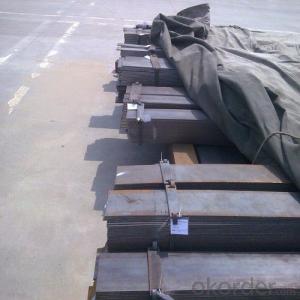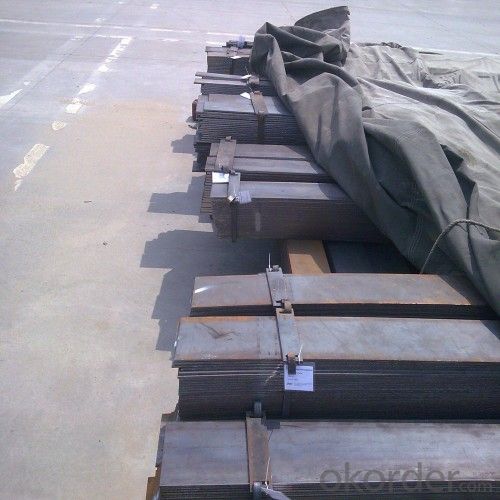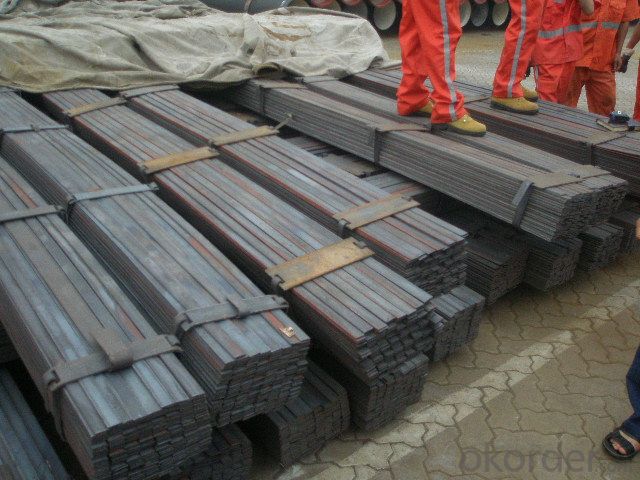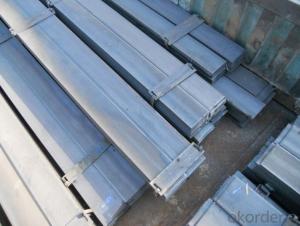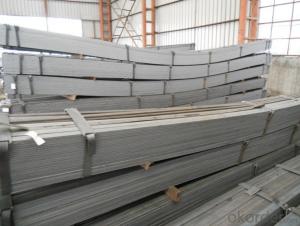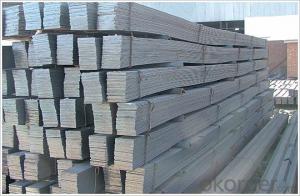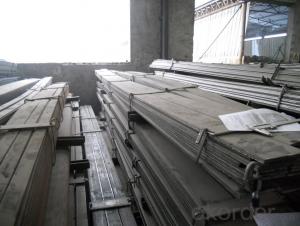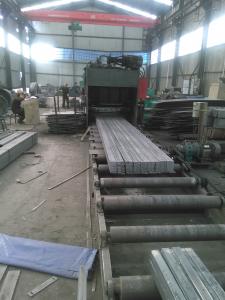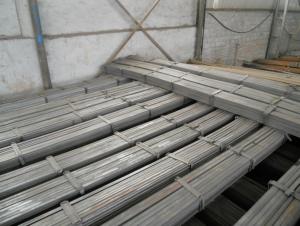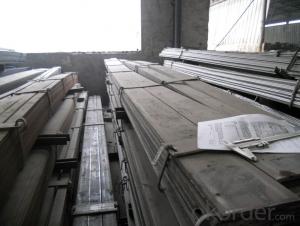Hot Rolled Flat Steel Bar with Material Grade Q235
- Loading Port:
- Tianjin
- Payment Terms:
- TT OR LC
- Min Order Qty:
- 25 m.t.
- Supply Capability:
- 10000 m.t./month
OKorder Service Pledge
OKorder Financial Service
You Might Also Like
OKorder is offering high quality Flat Bar at great prices with worldwide shipping. Our supplier is a world-class manufacturer of steel, with our products utilized the world over. OKorder annually supplies products to European, North American and Asian markets. We provide quotations within 24 hours of receiving an inquiry and guarantee competitive prices.
Product Applications:
Slit Cutting Flat Bars are ideal for structural applications and are widely used in the construction of buildings and bridges, and the manufacturing, petrochemical, and transportation industries.
Product Advantages:
OKorder's Flats Bars are durable, strong, and resist corrosion.
Main Product Features:
· Premium quality
· Prompt delivery & seaworthy packing (30 days after receiving deposit)
· Corrosion resistance
· Can be recycled and reused
· Mill test certification
· Professional Service
· Competitive pricing
Product Specifications:
Manufacture: Hot Rolled
Grade: Q195 – 235
Certificates: ISO, SGS, BV, CIQ
Length: 6m – 12m, as per customer request
Packaging: Export packing, nude packing, bundled
Chemical composition of Q235
Alloy No | Grade | Element(%) | ||||
C
| Mn
| S
| P
| Si
| ||
Q235
|
B
|
0.12—0.20 |
0.3—0.7 |
≤0.045 |
≤0.045
|
≤0.3
|
Physical properties of Q235
Alloy No | Grade | Yielding strength point(Mpa) | Tensile strength (Mpa) | Elongation after fracture(%) | ||||||
Thickness (mm) | Thickness (mm) | |||||||||
≤16 | >16--40 | >40--60 | >60--100 | ≤16 | >16--40 | >40--60 | >60--100 | |||
≥ | ≥ | |||||||||
Q235 |
B |
235 |
225 |
215 |
205 |
375--500 |
26 |
25 |
24 |
23 |
FAQ:
Q1: Why buy Materials & Equipment from OKorder.com?
A1: All products offered byOKorder.com are carefully selected from China's most reliable manufacturing enterprises. Through its ISO certifications, OKorder.com adheres to the highest standards and a commitment to supply chain safety and customer satisfaction.
Q2: How do we guarantee the quality of our products?
A2: We have established an advanced quality management system which conducts strict quality tests at every step, from raw materials to the final product. At the same time, we provide extensive follow-up service assurances as required.
Q3: The products are invoicing on theoritical weight or on actual weight?
A3: We can do it in both manners, according to the customers' request.
Images:
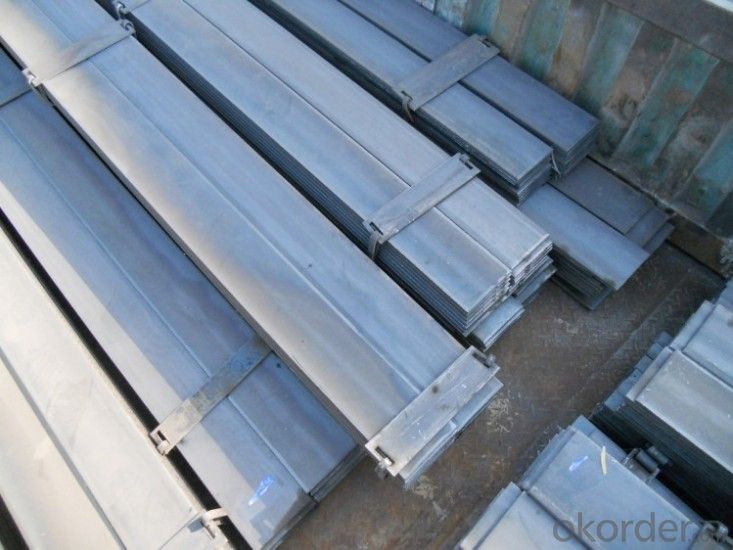

- Q: How do you determine the fracture toughness of a steel flat bar?
- To determine the fracture toughness of a steel flat bar, various standardized tests can be conducted. The most common test method is the Charpy V-notch (CVN) test, where a notched sample is subjected to impact loading and the amount of energy required to fracture the sample is measured. Another method is the compact tension (CT) test, which involves applying a controlled load to a pre-cracked sample and measuring the crack growth resistance. These tests provide valuable data on the toughness and resistance of the steel to fracture, enabling engineers to assess its suitability for specific applications.
- Q: How do steel flat bars perform in terms of fatigue resistance?
- Steel flat bars generally have good fatigue resistance due to their high strength and stiffness properties. They can withstand repeated loading and stress cycles without experiencing significant structural damage or failure. However, the specific fatigue performance of steel flat bars may vary depending on factors such as the steel grade, manufacturing process, surface finish, and design considerations.
- Q: How do steel flat bars perform in corrosive or acidic environments?
- Steel flat bars generally perform well in corrosive or acidic environments, but their resistance to corrosion depends on the type of steel used and the specific properties of the environment. Stainless steel flat bars, for example, are highly resistant to corrosion in most acidic or corrosive environments. This is because they contain a minimum of 10.5% chromium, which creates a protective oxide layer on the surface of the steel that prevents further corrosion. Additionally, stainless steel flat bars can be alloyed with other elements such as nickel or molybdenum to enhance their corrosion resistance even further. However, not all steel flat bars are as resistant to corrosion. Carbon steel flat bars, for instance, are susceptible to rust and corrosion in acidic or corrosive environments. This is because they lack the protective oxide layer present in stainless steel. In such cases, additional measures like galvanization or coating the flat bars with corrosion-resistant materials may be necessary to protect them from corrosion. Overall, it is important to consider the specific type of steel used and the nature of the corrosive or acidic environment when determining the performance of steel flat bars in such conditions. Consulting with experts or referring to corrosion resistance charts can provide more specific information on the suitability of steel flat bars in different environments.
- Q: Can steel flat bars be used for making brackets or supports for plumbing systems?
- Yes, steel flat bars can be used for making brackets or supports for plumbing systems. Steel is a strong and durable material that offers excellent support and stability, making it suitable for such applications. Additionally, steel flat bars can be easily fabricated and customized to meet specific plumbing system requirements.
- Q: Can steel flat bars be drilled?
- Yes, steel flat bars can be drilled. Steel is a versatile and strong material that can be easily drilled through using appropriate drill bits and drilling techniques. It is important to select the right type of drill bit for drilling steel, such as a high-speed steel (HSS) or cobalt drill bit, as these are designed to withstand the hardness of steel. Additionally, lubricating the drilling area with cutting fluid or oil can help reduce friction and heat buildup during the drilling process. Proper drilling techniques, including using moderate pressure and maintaining a steady drilling speed, will ensure accurate and efficient drilling in steel flat bars.
- Q: How do you prevent rusting on steel flat bars?
- To prevent rusting on steel flat bars, you can apply a protective coating like paint, oil, or a specialized rust inhibitor. Additionally, keeping the bars dry and storing them in a moisture-free environment can help prevent rust formation.
- Q: What are the different types of surface finishes for brass steel flat bars?
- Some common types of surface finishes for brass steel flat bars include polished, brushed, satin, antique, and patina finishes.
- Q: Can steel flat bars be used for making aerospace industry equipment or structures?
- Yes, steel flat bars can be used for making aerospace industry equipment or structures. Steel flat bars offer high strength and durability, making them suitable for various applications in the aerospace industry. They can be used for creating structural frames, support systems, and other components that require robust and reliable materials. Additionally, steel flat bars can be easily machined and welded, allowing for efficient manufacturing processes in the aerospace sector.
- Q: Are steel flat bars resistant to chemical corrosion?
- Steel flat bars are typically resistant to chemical corrosion. Steel is naturally strong and durable, and its resistance to corrosion can be improved through methods like coating or galvanization. However, the degree of resistance may differ based on the type of steel and the chemicals it encounters. Highly corrosive substances such as acids or alkalis can still cause corrosion over time. Hence, it is crucial to consider the steel's compatibility with specific chemicals to ensure long-lasting durability and performance.
- Q: How do you determine the yield strength of a steel flat bar?
- To determine the yield strength of a steel flat bar, several methods can be used. One common approach is to conduct a tensile test, also known as a tension test. This involves subjecting the steel flat bar to an increasing amount of tensile force until it reaches its breaking point. During this process, the stress and strain experienced by the steel are measured. The first step is to prepare the sample by cutting a flat bar of known dimensions from the steel material. The dimensions are crucial as they are used to calculate the cross-sectional area of the bar. This cross-sectional area is necessary to determine the stress experienced by the steel during the tensile test. The tensile test is typically performed using a universal testing machine. The steel flat bar is securely clamped into the machine, with one end held firmly while the other end is slowly pulled by a hydraulic or mechanical grip. As the bar is subjected to increasing force, the machine measures the corresponding elongation or deformation of the bar. The stress and strain experienced by the steel are calculated by dividing the force applied by the cross-sectional area and the change in length by the original length, respectively. Plotting these values on a stress-strain curve allows us to observe the behavior of the steel and identify its yield point. The yield strength of the steel flat bar is determined by identifying the point on the stress-strain curve where a significant increase in strain occurs without a proportional increase in stress. This point indicates that the steel has begun to deform plastically, meaning it has exceeded its elastic limit and entered the yield region. Once the yield point is identified, the corresponding stress value is recorded as the yield strength of the steel flat bar. It is typically expressed in units of force per unit area, such as megapascals (MPa) or pounds per square inch (psi). It is important to note that the yield strength can vary depending on factors such as the composition of the steel, its heat treatment, and any prior mechanical or thermal processing it has undergone. Therefore, to obtain accurate and reliable results, it is recommended to conduct multiple tests and average the obtained yield strengths.
Send your message to us
Hot Rolled Flat Steel Bar with Material Grade Q235
- Loading Port:
- Tianjin
- Payment Terms:
- TT OR LC
- Min Order Qty:
- 25 m.t.
- Supply Capability:
- 10000 m.t./month
OKorder Service Pledge
OKorder Financial Service
Similar products
Hot products
Hot Searches
Related keywords

